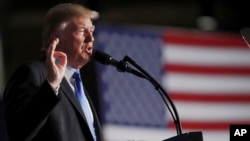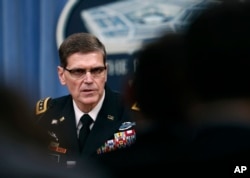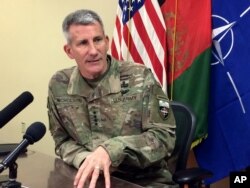Tuesday marks one year since U.S. President Donald Trump unveiled his South Asia strategy with a focus on Afghanistan. Since then, Afghanistan has seen some of the worst violence since the U.S.-led invasion almost 17 years ago.
In 2017, while announcing the strategy, Trump put forth a case for staying the course in Afghanistan and not allowing the country to become a haven for terrorists who would once again pose a threat to U.S. national security.
“I share the American people’s frustration. I also share their frustration over a foreign policy that has spent too much time, energy, money, and most importantly, lives, trying to rebuild countries in our own image,” he said at the time, vowing to end nation-building and only focus on U.S. national security interests.
A year after the announcement of the strategy, Afghan and U.S. officials defend that strategy and charge it is paying dividends in the sense that it has helped the peace talks move forward.
“The South Asia strategy is making a difference. I think under the South Asia strategy, we are increasing military pressure on the Taliban through the increased capabilities of the Afghan national security forces, in particular their special operators and their aviation assets,” Alice Wells, principal deputy assistant secretary for the Bureau of South and Central Asian Affairs, told a group of reporters at the U.S. State Department in June.
“The president’s strategy has underscored to the Taliban that we will deny them a military victory, and there is a commitment to stay,” she added.
Cautious optimism
Last month, during a trip to Afghanistan, Gen. Joseph Votel, commander of U.S. Central Command, said the president’s South Asia strategy is working.
“There is cause for cautious optimism and evidence that our South Asia strategy is working,” Votel said.
“The most dramatic evidence of this was manifested recently when our conditions-based approach allowed President Ghani and the Afghan National Defense and Security Forces to set the conditions for the first-ever, nationwide ceasefire,” he added.
Gen. John Nicholson, commander of U.S.-led NATO Resolute Support, echoed Votel’s assessment.
“I’ve seen progress in the last year that I haven’t seen in the previous 17 years, and that’s significant,” he said. “So, I say that some of these traditional metrics like levels of violence and population, while still relevant and important, should not outweigh the importance of advancing the peace process.”
Too soon?
Analyst Mathew P. Dearing of the Washington-based National Defense University believes it is too early to assess the effectiveness of the strategy.
“I think it is too soon to say one way or the other about the South Asia strategy,” Dearing told VOA. “Pessimists will point to the surge of Taliban attacks as a sign of its failure. Optimists will point to the opening of dialogue between the U.S. and the Taliban as a sign of success.”
“Both views are shortsighted. Ultimately, U.S. success in the region is dependent on factors we have limited control over — Pakistan’s support to proxies, Russia’s growing influence in the region, and most important — the 2019 Afghan presidential election,” Dearing said.
Michael Kugelman, deputy director and senior associate for South Asia at the Washington-based Woodrow Wilson Center, said the strategy has not worked.
“No matter how you slice it, the strategy hasn’t been very effective at all. The main objectives — getting Pakistan to crack down on terror safe havens, putting the Taliban on the defensive — haven’t come close to being achieved,” Kugelman said. “The one bright spot is that Afghanistan is closer to launching a peace process than at any time before.”
But even if the peace process works, Kugelman believes the Taliban would enter it from a position of strength and “that’s not something Afghanistan, the U.S. or the U.S. strategy would have wanted.”
Pakistan
Pakistan is considered a key stakeholder in Afghanistan. The country is believed to have influence over the Afghan Taliban and has long been accused by Washington for tolerating terror safe havens on its soil, a charge denied by Islamabad.
On Monday, Wells once again criticized Pakistan for not doing enough against terror safe havens in the country.
Talking to VOA, a spokesperson from Pakistan’s foreign office rejected the allegation and said, “Pakistan has already been playing its role for peace efforts in Afghanistan, and it has done enough. Now, it expects that all stakeholders should also play their due role.”
However, some analysts such as Pakistan-based Rasul Baksh Raees are optimistic that the new government of Pakistan would change things.
“With a new government in place in Pakistan, I am optimistic there will be improvement in relations between the United States and Pakistan. The relations had largely remained strained after President Trump criticized Pakistan for providing safe havens to terrorists last year in his South Asian strategy,” Raees told VOA.
“Now that Imran Khan is the new prime minister, he seems to be open to build bridges with all the countries, including our neighbors Afghanistan and India,” he added.
Privatization
In the midst of vicious multipronged attacks by the Taliban across Afghanistan in recent weeks, American businessman Erik Prince's plan to privatize the U.S. war in Afghanistan is reportedly receiving renewed traction within the Trump administration.
WATCH: Current Afghanistan-U.S. Strategy Has Been in Place for Year
But a spokesperson for Afghan President Ashraf Ghani told reporters in Kabul on Monday that U.S. and Afghanistan are on the same page when it comes to opposition to the privatization of the war in the country.
“It is a conspiracy of the enemies of Afghanistan and those who are afraid of the successes of the U.S. South Asia strategy,” Haroon Chakhansuri said.
“The strategy has had tangible results in Afghanistan and the region, including the successful implementation of the ceasefire during Eid days and the growing pressure on regional countries,” Chakhansuri added.
Rebecca Zimmerman of the Rand Corporation believes the privatization of the war has zero chance of success.
“Prince’s plan would outsource war in a profoundly different way than the U.S. has historically thought about it, and one that I think has absolutely no chance of being successful.” she told VOA. “Contractors are actually working on the basis of specified tasks, and they judge success by completing those tasks, not by actually winning a war.”
VOA's Madeeha Anwar and William Gallo contributed to this report from Washington.












